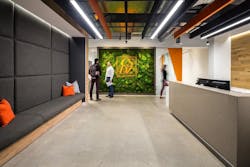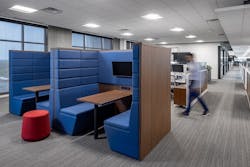Strategies for Conquering Workplace Acoustical Issues
Admit it: we’ve been spoiled.
While it had its obvious challenges, working from home lowered (or perhaps raised?) our tolerance for noise. And if it did raise it, that’s not necessarily a good thing.
“Hearing health conservation has become a really big theme in one of our latest beta features in the WELL rating system that focuses on audiology tests and how your employees’ hearing health is potentially deteriorating over time and how to manage that,” explained Ethan Bourdeau, sound concept lead at the International WELL Building Institute—where acoustics has been an integral part of achieving the WELL standard as early as version 1 of the program.
While the concern is already regulated by OSHA for the industrial sector, it’s quickly becoming a potential health risk in corporate and even education settings as well, where users are (or may soon be) attached to headsets for sometimes eight hours a day.
Furthermore, we’re starting to confront a new frontier in office design that has a variety of implications: “Our workspaces are broadcasting studios in a sense,” said Danijel Pocanic, regional design leader for NELSON Worldwide. “Because everything we do now has to be translated through a technology to other people and it’s often through video and audio. So, you have to be super aware of how you sound to other people as well as being able to hear other people clearly—because it’s something that is supporting your message.”
And all too often that message is not being well received, a fact that was true even before COVID hit and Zoom took over the world.
According to the Leesman Index’s The Workplace Experience Revolution survey (Part 2), “…noise levels remain a widespread and highly problematic issue, with a catastrophic average satisfaction score of just 33.4% across all new workplaces… .” The data was the result of a 2019 survey of more than 557,000 employee responses that measured the quality of offices worldwide across three main areas: activities, impact and features.
So how do we change this? The answer is tricky when it comes to building out a space whose functionality needs to bend to the constant whims of a pandemic that just won’t quit, and more importantly, the varying needs of employees trying to juggle everything all at once. But acoustics can be harnessed and made to work for, not against, employees with a good cocktail of design and technology strategies singing in harmony.
The Essential
One thing is for sure, and that is “everybody has a different new normal,” said Albert Maniscalco, partner at Cerami (consultants in acoustics, AV, IT and security)—but the hybrid work model will reign supreme.
“There’s people downsizing and giving up space and just as many people remodeling the space to adjust for this new environment,” Maniscalo explained. Either way, design, layout and function need to be of the utmost flexibility and that leads to even more challenges.
“In an open office environment where you normally have a lot of butts in seats, you have this normal din of the office humming. That’s not there anymore,” he noted. “People are trying to do work, and the background sound level is down, making the people that are there far more aware of the other few people that are there. So, we talk to our clients a lot about sound masking.”
A sound masking system—along with its partner sound scaping—is a grid of speakers that is typically hidden above an acoustical tile ceiling and creates a gentle blanket of sound that mimics HVAC noise. Running air is not uniform throughout the office, so masking fills in those blanks and makes that person’s key clicks, phone conversations or interoffice conversations a few desks or rows away less noticeable, making the office a much more attractive place to escape to and get some work done.
Sound scaping can be incorporated into the masking system and can make a space divisible without building walls. Scaping can create any variety of “environments” such as with the sounds of a park—a babbling brook, birds chirping or the breeze blowing. “Based on the content you are playing, you delineate if this is more of a quiet, heads down area, or this is more of a social area,” said Maniscalco. “It’s great for people looking for ways to entice people back into the office from home.”
Masking can also address privacy concerns by making up for the lack of performance from certain furniture choices or glass walls and fronts in today’s open office.
“Privacy is a function of two things: 50% the wall and 50% the background sound level, and those percentages will vary,” Maniscalco said. “The lower the background sound level is in the open office area outside a private office, the higher the performance of that wall and door need to be to achieve the desired level of privacy, and vice versa. Add in masking and now the wall and door don’t have to work as hard.”
[Related: How Lighting Can Address Acoustic Control in the Modern Office Setting]
The Traditional
When mixing your cocktail, don’t forget the workhorses—the tried-and-true solutions that still apply today and accomplish one of the most important aspects of acoustic comfort: sound absorption. Look to your big-ticket items that account for the most real estate first, particularly the ceiling, where baffles, stretched fabric, cellulose spray and even acoustic light panels can be great solutions.
“In most cases, we find that providing absorptive finishes at the floor isn’t advantageous, given that it’s just not necessarily the best surface to apply treatment to,” said Bourdeau. There are no absorption requirements for floor finishes in WELL version 2 pilot and version 2.
“The surfaces that work best and are recommended are fibrous and porous with an acoustically transparent outer layer. Fabric-wrapped panels are a really traditional design tool for increasing absorption in any given space or volume,” Bourdeau added.
But the composite construction of a building facade also needs to be considered, he explained, as glazing and windows are considered a limiting factor when it comes to controlling externally generated noise. “WELL buildings promote increased natural light, but that has a potential negative impact on the degree of acoustic performance that calls for holistic solutions. The more glazing you have, the more easily noise can transmit from, say, a highway or busy thoroughfare outside into an office.”
The Now
While a necessary ingredient, “customers are also looking for more than a straightforward baffle,” said Richard Ellerbeck, global acoustic consultant for BuzziSpace. “Recent trends have seen a turn towards more functional acoustic solutions, such as acoustic furniture and acoustic lighting.”
Offerings such as phone booths and more modular furniture, as well as various “room within room” options like pergolas, are giving designers the opportunity to play with layout and flexibility. High-backed booths and seating or pieces with detachable screen surrounds can instantly transition to a focus area for private work or more intimate conversations. “Those are all the tools that we’re really focused on right now,” mentioned Pocanic.
[Related: 5 Best Practices for Designing Better Ceilings]
The Trimmings
Since we’ve now arrived in 2022, speech intelligibility is an increasingly important part of the acoustics conversation.
“Call quality and speech intelligibility when using teleconferencing equipment in meeting rooms is one of the fundamental issues our clients encounter,” Ellerbeck explained.
Projects undergoing WELL version 2 pilot and version 2 are required to consider four types of work: focused work, collaborative work, collaborative hybrid work (communicating into a computer) and solely virtual.
“How do we accommodate that?” asked Bourdeau. “It reveals other design considerations that must be accounted for, such as how does reverberation time in a room suppress the vocal quality of someone speaking to you from a conference room in one office to maybe a packed conference room in another regional office, having a collaborative conversation.”
This not only means furniture and surface options need to work harder, but audio device selection needs to be taken into more careful consideration, which also leads us back to where we started—sound’s overall effect on wellness.
“Phones might have built in noise suppression algorithms in their digital processing system, but we now have access to Bluetooth headsets that have microphones built in and preferably sit closer to your mouth,” Bourdeau said. “They also have built in active noise cancellation that suppresses sounds that are not your voice or within a certain sphere around the microphone. Those polar patterns play a huge role in the way the microphone itself, not just the room acoustics, play into improving speech intelligibility over a virtual call.”
Software programs such as Krisp (which Cerami is studying with certain clients) can also eliminate a lot of background sound that might be disturbing a video chat. “It’s the combination of all these things that really help provide a meaningful difference,” said Maniscalco. “Sometimes just masking or an acoustic ceiling isn’t enough.”
Read next: Why Acoustics Matter So Much in Medical Facilities
About the Author

AnnMarie Martin
AnnMarie has been covering the commercial design space since 2005 and has been on the editorial staff at i+s since 2011. Her style and vision has helped the brand evolve into a thought leader in purpose-driven design and cultural movements shaping the way we live and work. She returned to the role of editor in chief at the start of 2023 and her journalism and fiction writing background have helped to craft bi-monthly issues that don’t just report the latest industry news, but tell a cohesive tale of some of the biggest topics facing designers today. She can always be reached at [email protected].


